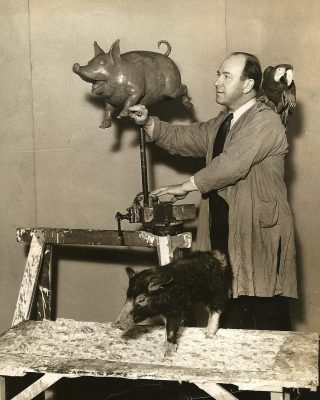Tony Sarg (1880 – 1942)
 Born to a German father and English mother, Tony Sarg learned creative skills from both of his parents. He rebelled against his military training to seek his dream of becoming an illustrator. Then, to distinguish himself as an artist and to promote his career, he took up marionettes as a hobby and performed them for his friends.
Born to a German father and English mother, Tony Sarg learned creative skills from both of his parents. He rebelled against his military training to seek his dream of becoming an illustrator. Then, to distinguish himself as an artist and to promote his career, he took up marionettes as a hobby and performed them for his friends.
Little information existed on puppetry early in the 20th century as puppeteers regarded their craft as secret material to be guarded by those in the business. Tony Sarg, however, spent many days watching a well known puppeteer in England, Thomas Holden, and figured out for himself the tricks of the trade. With this knowledge and fleeing from the anti-German attitudes in England at the outbreak of World War I, Tony Sarg immigrated to America with his family.
In New York City, Tony Sarg continued to distinguish himself from other artists with his puppetry hobby. He gained a reputation in all the social circles as a friend, practical joker and the life of any party. His indefatigable work ethic and countless ideas made him a business man with the Midas touch for making a profit.
Puppet technology played a major role in his varied business ventures. Such ventures included making animated cartoons, mechanical figures in window displays, advertising ideas and parade balloons for Macy’s Department Store.
Tony Sarg produced and toured puppet shows throughout the United States. He wrote and illustrated children’s stories and ‘how-to’ publications on marionettes, making it possible for children to participate in puppetry as a home or school activity. Unlike his European peers, Tony Sarg believed in revealing how his tricks were produced. This along with his charming personality and keen business ideas, Tony Sarg helped popularize puppetry in America on a grand scale.
Many talented individuals began in Tony Sarg’s studios. The most notable examples must include
Bil Baird and Margo and Rufus Rose who later ventured out on their own and became well renowned puppeteers. Bil Baird joined Tony’s group as a puppeteer in 1927 and became a supervisor to many New York ventures that included the parade balloons. Rufus Rose joined the group in 1928 where he met the already employed Margo, married her, and together they became famous for their creation of the 1950’s celebrity, Howdy Doody.
In 1939, Tony Sarg’s business went bankrupt. Puppets were sold or given to employees to settle his debts. Tony Sarg died in 1942, three weeks after an emergency appendectomy.
The production of Alice in Wonderland emphasized the abilities of the marionettes as opposed to remaining true to the original story, a point which drew much criticism. The character of Alice began the show as a real actress and was replaced later by a look-alike puppet.
Suggested reading:
Tony Sarg: Puppeteer in America 1915-1942
by Tamara Robin Hunt
Charlemagne Press